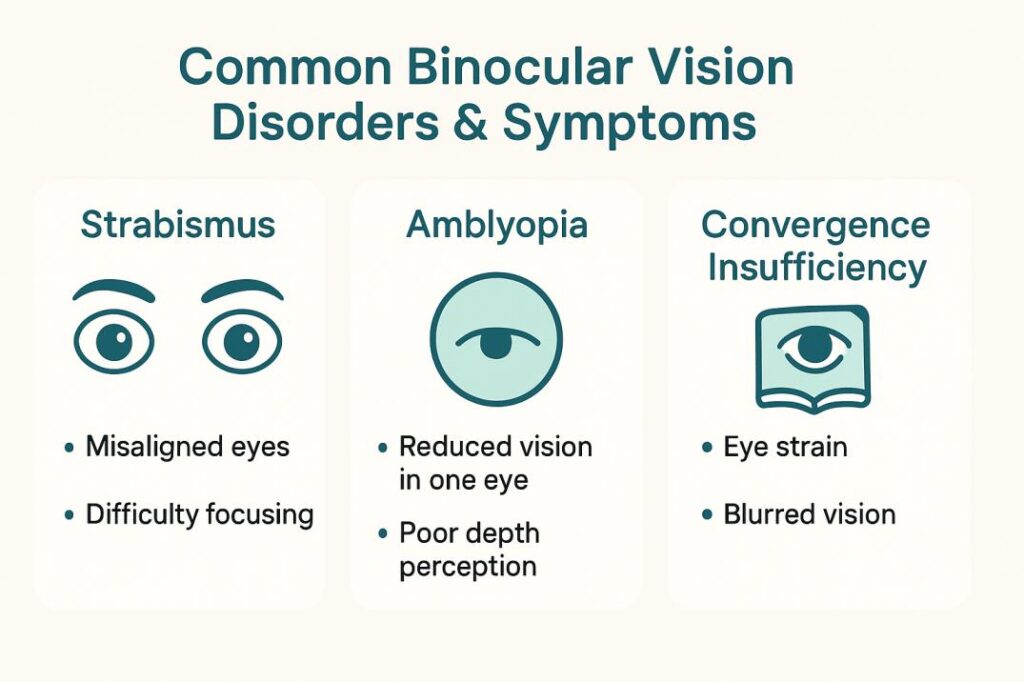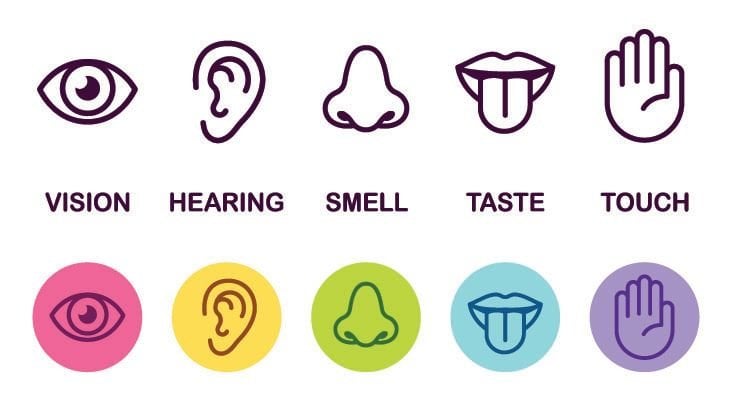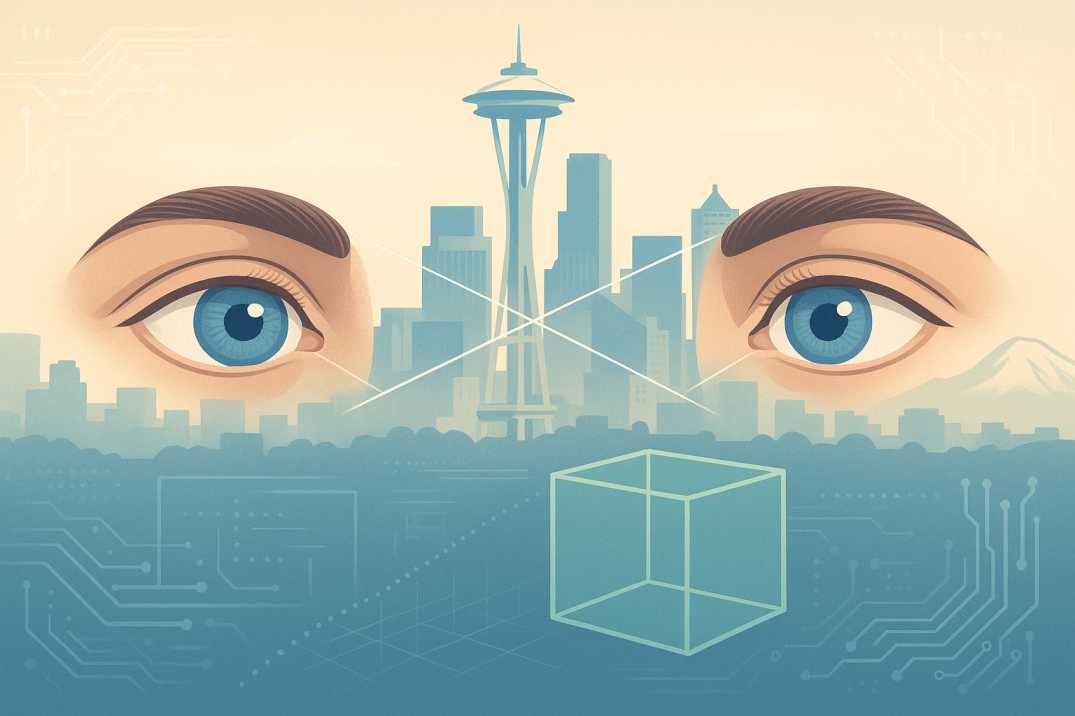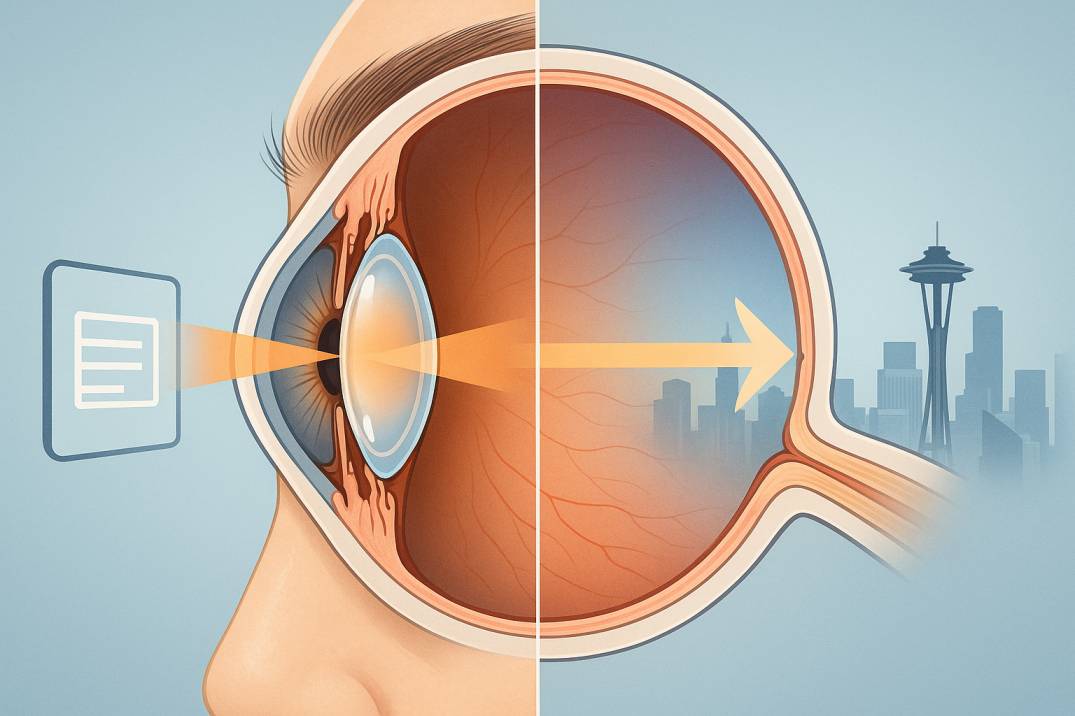Binocular Vision: Disorders, Treatment & Depth Perception
Binocular vision merges dual-eye inputs into one 3D image—key for depth perception. Discover how disorders arise, treatments like vision therapy, and why early exams prevent lifelong vision issues.
Key Takeaways: Binocular Vision at a Glance
-
Binocular vision enables depth perception by merging input from both eyes into a single 3D image, critical for everyday tasks like driving, sports, and reading.
-
Early childhood is a vital window for developing healthy binocular vision—delayed diagnosis can result in long-term visual impairment.
-
Beyond strabismus and amblyopia, conditions like convergence insufficiency and divergence excess are common yet underdiagnosed, especially in school-aged children.
-
Prolonged screen time and VR use can trigger or worsen binocular vision dysfunction, emphasizing the need for regular screen breaks and preventive habits.
-
Non-invasive treatments like vision therapy and VR-based neuroplasticity apps can effectively restore visual coordination without surgery.
-
Specialized diagnostic tools such as prism bars, stereopsis tests, and synoptophores help tailor precise treatment plans.
-
Pediatric eye exams at ages 6 months, 3 years, and before school are critical, as recommended by AAPOS, to catch binocular vision issues early.
-
Workplaces and homes can adapt with visual aids like high-contrast markers and specialized lenses to support those with impaired depth perception.
The human visual system is a complex network including the eye, ocular nerves, and key brain areas that process visual information. Under most circumstances, we use information from both eyes to create a single visual image. This ability to converge information from both eyes is called binocular vision. In some cases, the eyes fail to seamlessly meld visual information into a coherent image. An eye care provider can assess vision to determine if there are problems with binocular vision that require further care.
How Does Binocular Vision Work?
Unlike some other animals, humans’ eyes are both set on the front of the face, permitting binocular vision. Each eye has a field of view, which is the area that you can see when you close one eye. The centers of the eyes’ fields of view overlap with one another, although visual information in the periphery can only be detected by one eye. This information is transmitted to an area of the brain in the back of the head, which synthesizes the overlapping visual information to make a single coordinated image.
Binocular Vision and Depth Perception
One of the reasons that binocular vision is so important is that it allows us to perceive depth and relationships between objects. Each eye sees slightly different spatial information and transmits these differences to the brain. The brain then uses the discrepancies between the two eyes to judge distance and depth. The result is the ability to see a 3-D image and distinguish the relationships between objects. Depth perception is technically called stereopsis or stereoscopic vision.
Causes of Binocular Vision Problems
If the eyes can no longer maintain their correct position or focus on the same object, the result is problems with binocular vision. In cases of strabismus, or cross-eye, the eyes are not properly aligned, with one is drifting from its normal position. Strabismus causes the brain to have difficulty synthesizing visual images from each eye, resulting in impaired binocular vision and depth perception. Amblyopia, or lazy eye, is another condition that causes binocular vision problems. Amblyopia occurs when the brain ignores input from one eye, affecting depth perception and other visual abilities.
Fortunately, most problems with binocular vision are easily treated through eyeglasses, vision therapy, or surgery. Receiving a thorough annual optometry exam — especially during childhood when the visual system continues to develop — is essential to detect these eye problems. Your eye care provider can recommend treatment options that correct or manage problems with binocular vision.
Development of Binocular Vision in Childhood
Binocular vision develops gradually during early childhood, with neural pathways forming as the brain learns to merge inputs from both eyes. Early detection of issues is critical, as untreated problems can lead to permanent vision deficits.
Key Stages & Interventions
-
0–4 months: Infants begin tracking moving objects but lack coordinated eye movements.
-
5–8 months: Depth perception emerges as eyes start working together.
-
1–7 years: Critical period for refining stereopsis (3D vision). Neural plasticity allows the brain to adapt, making treatments like patching for amblyopia most effective.
Red Flags for Parents
-
Frequent eye rubbing or squinting.
-
Poor hand-eye coordination (e.g., difficulty catching balls).
-
Tilting the head to see objects.
Pediatric eye exams at 6 months, 3 years, and before kindergarten are recommended by the American Association for Pediatric Ophthalmology and Strabismus (AAPOS) to ensure healthy binocular vision development.
Types of Binocular Vision Disorders Beyond Strabismus and Amblyopia
While strabismus and amblyopia are well-known, lesser-known disorders can disrupt daily life and require specialized care.
Underrecognized Conditions
-
-
Symptoms: Eye strain, blurred vision when reading, and headaches.
-
Prevalence: Affects 5–13% of school-aged children (NIH study).
-
-
Divergence Excess:
-
Causes: Overactive outward eye movement, leading to double vision.
-
Impact: Difficulty focusing on distant objects (e.g., whiteboards).
-
-
Suppression: The brain ignores input from one eye to avoid double vision, reducing depth perception.
Diagnostic Techniques for Binocular Vision Issues
Eye care professionals use specialized tests to identify binocular vision dysfunction, ensuring accurate treatment plans.
Common Assessments
-
Cover Test: Detects misalignment by covering one eye and observing movement.
-
Hirschberg Test: Measures corneal light reflection symmetry.
-
Stereopsis Tests:
-
Randot Test: Uses polarized glasses to assess 3D vision.
-
Titmus Fly Test: A child-friendly tool with a 3D image of a fly.
-
Advanced Tools
-
Synoptophore: Measures eye alignment and fusion ability.
-
Prism Bars: Quantify misalignment severity for corrective lens prescriptions.
Impact of Technology on Binocular Vision
Prolonged screen use strains the visual system, exacerbating or triggering binocular vision problems.
Key Concerns
-
-
Symptoms: Dry eyes, headaches, blurred vision.
-
Cause: Reduced blink rate and prolonged near-focus effort.
-
-
Virtual Reality (VR):
-
Challenges: Mismatch between virtual 3D depth and fixed focal distance.
-
Risk: Temporary double vision or dizziness in users with weak fusion skills.
-
Prevention Strategies
-
Follow the 20-20-20 rule: Every 20 minutes, look 20 feet away for 20 seconds.
-
Use blue light filters or anti-glare screens.
-
Schedule annual eye exams to monitor changes.
Treatment Options: Beyond Glasses and Surgery
Non-invasive therapies can retrain the brain-eye connection, offering long-term relief for many patients.
Evidence-Based Therapies
-
-
Pencil Push-Ups: Focus on a moving pencil to improve convergence.
-
Brock String: Uses colored beads on a string to enhance eye teaming.
-
-
Prism Lenses: Redirect light to reduce double vision without surgery.
-
Neuroplasticity Apps:
-
Tools like Vivid Vision use VR to improve depth perception in amblyopia.
-
Binocular Vision in Daily Life
Healthy binocular vision is essential for tasks requiring spatial judgment and coordination.
Real-World Applications
-
Driving: Depth perception helps gauge distances between cars.
-
Sports: Baseball players rely on stereopsis to track fast-moving balls.
-
Workplace: Architects, surgeons, and pilots need precise depth perception.
Adaptations for Impaired Vision
-
Use high-contrast markings on stairs to prevent falls.
-
Employers can provide 3D glasses or enlarged screens for detail-oriented tasks.
Binocular vision is essential for how we perceive the world in three dimensions, from depth perception to hand-eye coordination. Understanding its development, recognizing early warning signs, and taking action when dysfunction arises can protect visual health across a lifetime. With modern diagnostic tools and evidence-based therapies, most binocular vision issues—especially when caught early—are highly treatable.
If you or your child experiences frequent eye strain, difficulty focusing, or poor depth perception, don’t wait. Schedule a comprehensive eye exam with your local optometrist today to ensure your visual system is functioning at its best. Early detection can make all the difference in lifelong visual comfort and clarity.
FAQs
-
What is binocular vision?
Binocular vision is the ability to merge visual inputs from both eyes into a single, cohesive image. This process relies on overlapping fields of view and brain synthesis in the occipital lobe, enabling depth perception (stereopsis) and spatial awareness.
-
How does binocular vision affect depth perception?
-
Why are childhood eye exams critical for binocular vision?
-
What are common binocular vision disorders besides lazy eye?
-
How do eye doctors diagnose binocular vision problems?
-
Can screen time worsen binocular vision issues?
-
What non-surgical treatments improve binocular vision?
-
How does impaired binocular vision impact daily life?
-
When should someone seek care for binocular vision problems?
-
Will VR headsets harm binocular vision?
-
How do I know if I have binocular vision dysfunction (BVD)?
-
What causes binocular vision dysfunction?
-
How is binocular vision dysfunction diagnosed?
-
Can binocular vision dysfunction be treated?
-
Why do I experience difficulty driving with binocular vision problems?
-
How does binocular vision affect reading and learning?
-
What is a binocular vision assessment like?
-
Are children commonly affected by binocular vision problems?




